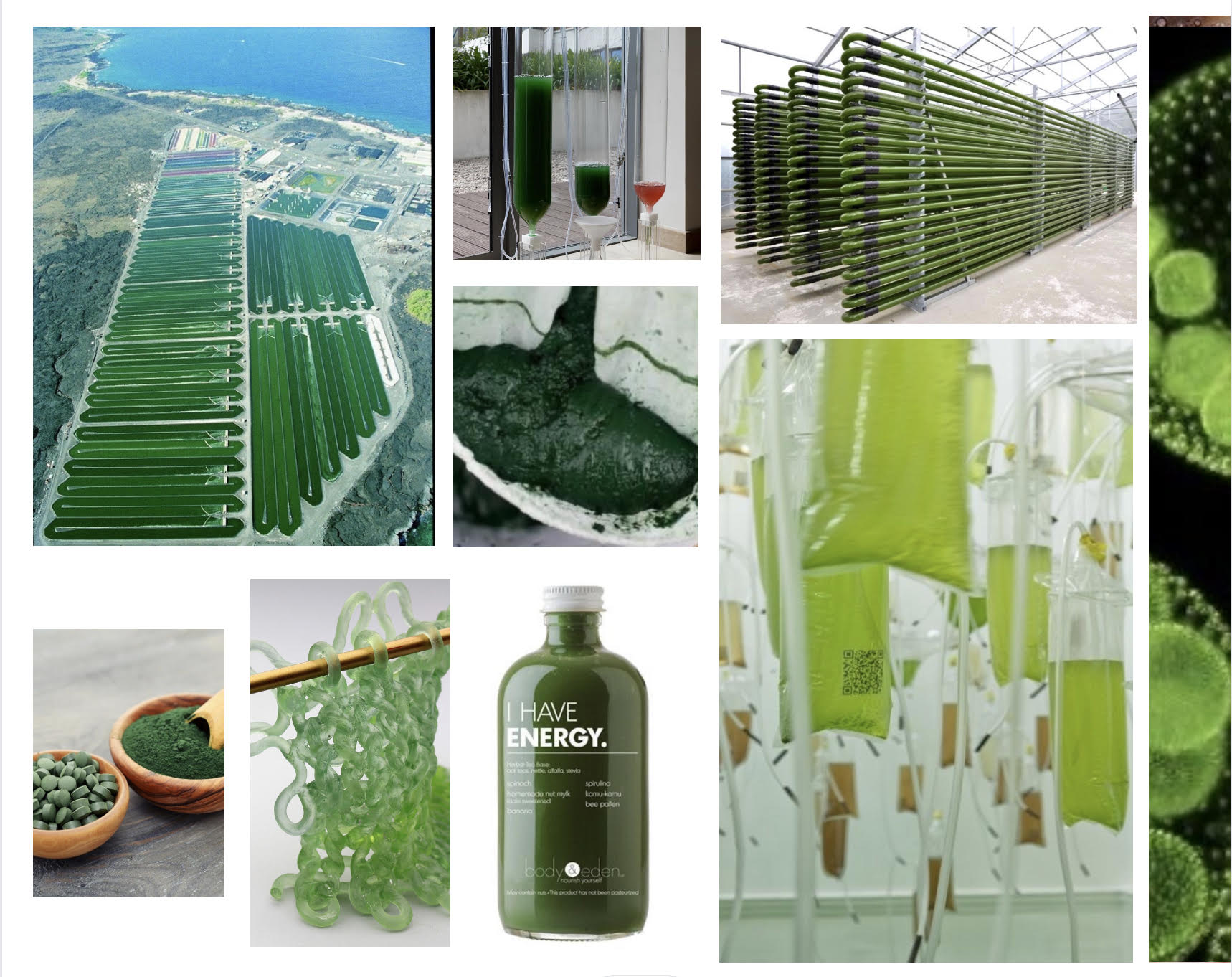Microalgae¶

What are Microalgae¶
Microalgae are single-celled photosynthetic organisms found in water, land and air that are capable of producing oxygen through photosynthesis. These algae are important to the aquatic food chain, as they are a source of food for small marine animals and fish.
These organisms are responsible for most of the aquatic ecosystem and 40% of the total photosynthesis of the planet.
There are more than 30,000 species of microalgae of which barely 5% are studied and only 20 species are commercially exploited. We have a huge interest due to its high lipid content and its fast growth.
WHAT ARE ALGAE? here a nice documentation with a lot of info about micro/macro Algae by EABA
Types¶
Some of the best known microalgae are:
-
Spirulina: A green microalgae that is used as a nutritional supplement and is believed to have health benefits such as lowering cholesterol and improving the immune system.
-
Chlorella: Also a green microalgae that is used as a nutritional supplement due to its high protein, vitamin and mineral content.
-
Diatoms: Single-celled microalgae with silica cell walls. These algae are important for oxygen production in the oceans and are used in the food and cosmetics industry.
-
Dunaliella: is a orange microalgae found in salt water that can tolerate extreme salinity conditions. It is used in the production of beta-carotene, which is used in the food and cosmetics industry.

Currently strains in online store at Spanish Algae Bank
Spirulina¶
For this first prototype, I have decided to work with spirulina because it is one of the easiest species to cultivate but also because it has many properties which we can make use of it:
High tolerance to different growing conditions: Spirulina is able to grow in a wide range of pH, temperature and light conditions.
Fast growth: Spirulina has a very high growth rate, which means that it can be harvested in a short period of time, can be up to 2 times per day, which means that a small amount of crop can generate large amounts of biomass in a short period of time.
Resistance to pests and diseases: Spirulina is resistant to many pests and diseases. it does not need chemical products.
Will conquer the planet¶
Microalgae have great potential in a wide range of industries, including food, energy, agriculture, medicine, biotechnology and cosmetics. The future of microalgae looks very promising due to the following reasons:
-
Sustainability: Microalgae are a sustainable source of biomass and can be grown in different types of water, including saltwater, freshwater and wastewater.
-
Feedstock: Microalgae are rich in nutrients such as protein, vitamins and minerals, and can be used to produce healthy foods such as food supplements, animal feed and human food.
-
Energy: Microalgae also have great potential as a source of biofuels, as they can produce large amounts of oils and lipids that can be transformed into fuels.
-
Biotechnology: Microalgae are also an important source of bioactive compounds that have antimicrobial, antioxidant and anti-inflammatory properties, making them useful in the production of pharmaceuticals and cosmetics.
-
Agriculture: Microalgae can also be used as fertilizers to improve soil quality and increase crop productivity.
In summary, the future of microalgae looks bright due to their versatility and their ability to address several global challenges, such as food security, sustainable energy and human health.
History¶
The use of microalgae as food dates back to the era of the Aztecs, when they collected masses of algae (probably cyanobacteria) in Lake Texcoco. These were used to make bread rolls that were then used as food. The first microalgae isolated and maintained in axenic conditions was Chlorella vulgaris, in 1890. However, it was not until the 1940s that studies began, focusing specifically on the physiology and biochemistry of these microorganisms. The idea of producing microalgae on a large scale originated in Germany during the 1940s using diatoms.
Aztecs¶
It is said that spirulina was used for medicinal purposes, and that it was considered a sacred food.
Aztecs harvest spirulina in large quantities, and it is believed that its consumption was one of the reasons why the Aztec civilization managed to prosper in a region where food resources were limited.
With the arrival of the Spanish conquistadors in the 16th century, the tradition of collecting and consuming spirulina in Mexico disappeared. However, spirulina has been rediscovered in modern times for its nutritional value, and today it is produced and consumed all over the world.
Chad Lake¶

Spirulina has been harvested from Lake Chad for more than 1,000 years.
In the 1970s, spirulina began to be produced commercially in several African countries, especially in Chad and south of the Sahara. Spirulina production has had a positive impact on the economy of these regions, providing employment and generating income for local communities.
The following important videos is really inspirational documentation about how they cultivated Spitulina in Togo, West Africa in 1980. This project inspired many dozens of other spirulina algae farms all over the world. I recommend watching this video as it shows the entire production process, from cultivation to harvesting and installation.
Commercial Production¶
Large-scale commercial cultivation of microalgae began in the early 1960s; in Japan with the cultivation of Chlorella. This was followed in the early 1970s with the establishment of a spirulina harvesting and cultivation facility in Lake Texcoco, Mexico. In 1977, a commercial spirulina plant was established in Thailand. And by 1980 there were 46 large-scale factories in Asia; these produced more than 1000 kg of microalgae (mainly Chlorella) per month.

The commercial production has been increasing in recent years due to their potential as a source of biomass for the production of biofuels, food, chemicals and pharmaceuticals.
